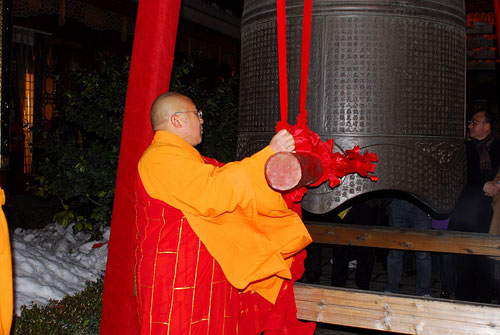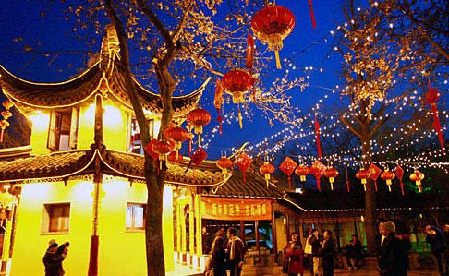Introduction
Updated: 2011-12-23
|
|||||||||
Dang, dang, dang... With the sounds of ancient bells ringing out at midnight on Chinese New Year's Eve in China, people all over the country celebrate the coming of the Year.

Striking bells has been a traditional way for the Chinese to greet the New Year since ancient times. At midnight, the bells at the Hanshan Temple in Suzhou, Jiangsu province, are struck 108 times to mark the new year's arrival.
The bell at the Hanshan Temple is considered to have the clearest sound. The bell and the temple which were both built in the Liang Dynasty (AD 502-557) are familiar to almost every Chinese because of a well-known poem written by Zhang Ji, a famous poet in the Tang Dynasty (AD 618-907): "At Hanshan Temple outside Gusu Town, my boat arrived to the sound of the bell at midnight."
Since 1979, gathering to listen to the peeling of the Hanshan Temple Bell at midnight on the eve of the new year has become a popular event among both local people and tourists.
Symbolic function
In Chinese history, bells had always had a special function and importance, going back even further than the history of written characters.
Bells were struck not only to mark the passage of time, but were also a symbol of imperial authority and religious sacredness.
Starting in the Ming Dynasty (1368-1644) when saying goodbye to the old year and welcoming the new, bells would be struck 108 times.
It is said that the number signifies the 12 months, 24 solar periods and 72 climate divisions.
It is also said that Buddhists believe that people have 108 worries, and that striking the bell108 times can remove them.
The custom was also taken to Japan by the famous Monk Jianzhen in the Tang Dynasty and later became popular among Japanese people.
Archaeologists and historical experts consider that the bell and drum, another special musical instrument, both first appeared in China about 5,000 years ago and were used in important social activities.
Because of the importance of bells and drums, they were placed in special buildings called bell towers and drum towers, and in ancient China such towers were seen in imperial palaces, temples and in every town.
Legend
There have been various legendary tales about the Bell Tower.

In the Ming Dynasty, tens of thousands of people were killed in several earthquakes in the Guanzhong Plain in Shaanxi. People said that a gigantic dragon in a huge underground river that flowed beneath the city caused the earthquakes.
When local officials heard this, they ordered all the blacksmiths of the city to make a chain about 300 metres long to chain the dragon in the underground river, under the centre of the city.
Then they ordered 5,000 skilled craftsmen to build a tower over the place where the dragon was chained so that it would be unable to move and could cause no more calamities in the city.
The tale, which may sound absurd, reveals the importance that people attach to the bell tower.
Another legend is about Zhu Yuanzhang, the first emperor of the Ming Dynasty. Zhu was born to a poor farming family. His parents died when he was still very young, and he had to herd sheep for the rich to survive, and then went to live in a temple, where he became a monk.
Many years later when he ascended the throne, he was afraid of being deposed by someone of real "dragon" (i.e. royal) blood. Therefore, he ordered bell towers to be built all over the country to repress the "dragon spirits."